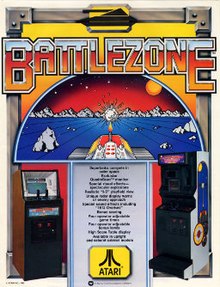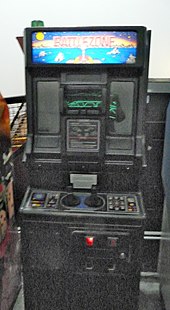Battlezone (1980 video game)
Battlezone (1980 video game)
This article's lead section may be too short to adequately summarize its key points. (November 2018) |
| Battlezone | |
|---|---|
 Promotional arcade poster | |
| Developer(s) | Atari, Inc. |
| Publisher(s) | Atari, Inc. |
| Designer(s) | Ed Rotberg Owen Rubin Roger Hector |
| Platform(s) | Arcade, Apple II, Atari 2600, Atari 8-bit, Atari ST, Commodore 64, IBM PC, VIC-20, ZX Spectrum |
| Release | Arcade November 1980[1] Atari 2600
1987[2] |
| Genre(s) | Vehicular combat First-person shooter[3][4][5] |
| Mode(s) | Single-player |
Battlezone is a first-person shooter tank combat arcade game from Atari, Inc. released in November 1980. The player controls a tank which is attacked by other tanks and missiles. The game is considered to be the "first big 3D success".[6]
Gameplay[edit]
This section does not cite any sources. (November 2018) (Learn how and when to remove this template message) |
The game uses wireframe vector graphics on a black and white (with green and red sectioned color overlay) vector monitor. Gameplay is on a flat plane with a mountainous horizon featuring an erupting volcano, distant crescent moon, and various geometric solids (in vector outline) like pyramids and blocks. The player can hide behind the solids or, once fired upon, maneuver in rapid turns to buy time with which to fire. The geometric solid obstacles are indestructible, and can block the movement of a player's tank. However, they are also useful as shields as they block enemy fire as well.
The player views the screen, which includes an overhead radar view, to find and destroy the rather slow tanks, or the faster-moving supertanks. Saucer-shaped UFOs and guided missiles occasionally appear for a bonus score. The saucers differ from the tanks in that they do not fire upon the player and do not appear on radar.
There is a gameplay modification at 100,000 points if the proper conditions are met. When executed properly the next appearing Supertank will not attack and will retreat. A tank icon will then appear at right on qualified high score listings.
Cabinet[edit]
This section does not cite any sources. (November 2018) (Learn how and when to remove this template message) |
Battlezone was housed in a standard upright arcade cabinet with a novel "periscope" viewfinder which the player used to view the game. The game action could also be viewed from the sides of the viewfinder for spectators to watch. A later, less common version of the cabinet removed the periscope to improve visibility to non-players and improve the ergonomics for players who could not reach the periscope. This modification also was welcomed by some operators, who felt that the small windows present in the "periscoped" version did not attract enough attention to the game when played.
A smaller version of the cabinet (known as a "cabaret cabinet") also existed with the screen angled upwards, and no periscope. A cocktail table version was tested as a prototype but not produced; it lacked the color overlays as the display would have to flip for opposing players.
The controls consisted of left and right joysticks, which could only be moved in the Y (vertical) axis, each controlling the treads on that side of the player's tank. One joystick contained a button used to fire projectiles at enemy targets.
Development[edit]
Owen Rubin, who shared an office with Ed Rotberg, came up with the idea of making the volcano in the background erupt, and coded the animation for it.[7]
Ports[edit]
In the 1980s, Battlezone was ported to the Apple II, Atari 8-bit family, Atari 2600, Commodore 64, VIC-20, IBM PC, ZX Spectrum, and later the Atari ST. The ports to non-Atari systems were from Atarisoft. The ZX Spectrum version was published by Quicksilva.
The Atari 8-bit version was released on cartridge in 1987 in the styling of the then-new Atari XEGS.[2] An Atari 5200 port was scheduled for release in November 1983, but was cancelled.[8]
The Atari 2600 version uses raster graphics instead of vectors and has a third person view where the tank is visible.
The Atari ST port contains large parts of the original 6502 code which is emulated.[9]
Reception[edit]
This section needs expansion. You can help by adding to it. (October 2017) |
Battlezone was well received, earning an Honorable Mention for "Best Commercial Arcade Game" in 1982 at the Third Annual Arkie Awards. It was runner-up, behind Pac-Man.[10]:76
The Bradley Trainer[edit]
A version called The Bradley Trainer (also known as Army Battlezone or Military Battlezone) was designed for use by the U.S. Army as targeting training for gunners on the Bradley Fighting Vehicle.[11] It was commissioned by a consultant group of retired generals.[12]
Approaching Atari in December 1980, some developers within Atari refused to work on the project because of its association with the Army,[13] most notably original Battlezone programmer Ed Rotberg.[14] Rotberg only joined after he was promised by management that he would never be asked to do anything with the military in the future.[15] According to Rotberg, it took him three months of constant work to develop the prototype version of The Bradley Trainer.[12] Only two were produced; one was delivered to the Army and is presumed lost, and the other is in the private collection of Scott Evans,[16][17] who found it by a dumpster in the rear parking lot at Midway Games.
The gunner yoke was based on the Bradley Fighting Vehicle control and was later re-used in the popular Star Wars game.[15] The Bradley Trainer differs dramatically from the original Battlezone as it features helicopters, missiles, and machine guns; furthermore, the actual tank does not move—the guns simply rotate.
Legacy[edit]
Because of its use of first-person pseudo 3D graphics combined with a "viewing goggle" that the player puts his or her face into, Battlezone is sometimes considered the first virtual reality arcade video game.[18]
Related games and rereleases[edit]
- Battlezone 2000 for the Atari Lynx was released in 1995.[19]
- It was included in the 1996 Battlezone / Super Breakout combo for the Game Boy.[20]
- Activision developed an authorized Battlezone game in 1998. Despite having the same name, it is not an arcade game, but a more complicated tank piloting strategy game. Battlezone II: Combat Commander is the 1999 sequel.
- A re-imagining of Battlezone was developed by Paradigm Entertainment and released for the PlayStation Portable.[21]
- In 2013, Rebellion Developments bought the Battlezone franchise from the Atari bankruptcy proceedings.[22] In 2016, a virtual reality game titled Battlezone was released for the PlayStation 4.[23] It was ported to Microsoft Windows in 2017.[24] It supports Oculus Rift, HTC Vive and PlayStation VR.[24]
- In 2008, an updated version of Battlezone was released on Xbox Live Arcade by Atari Inc.[25]
Clones and inspired games[edit]
- Stellar 7 (1983) for the Apple II and Commodore 64
- Robot Tank (1983) by Activision for the Atari 2600 is similar to the official port of Battlezone.
- Encounter (1983) for the Atari 8-bit computers and Commodore 64 is also similar to 2600 Battlezone, with scaled sprites instead of wireframe 3D graphics. It includes the missiles and saucers of the original.
- 3D Tank Zone (1983) for the Acorn Electron and BBC Micro by Dynabyte
- 3D Tank Duel (1983) and Rommel's Revenge (1984) for the ZX Spectrum
- Rommel 3D (1985) for the TRS-80 Color Computer
- bzone for Domain/OS, later rewritten for the X Window System and Macintosh [26]
- Spectre (1991) for the Macintosh
- BZ for the Silicon Graphics workstations added network play.[27]
- Stramash Zone (2018) was self-published for the Vectrex.[28]
See also[edit]
References[edit]
- ^ "Production Numbers" (PDF). Atari. 1999. Retrieved 19 March 2012.
- ^ a b "Battlezone". Atari Mania.
- ^ Dalton, Andrew (December 15, 2016). "'Battlezone' Classic Mode fulfills the promise of '80s VR". Engadget. Retrieved September 23, 2017.
It's been 36 years since Atari released Battlezone and effectively created the first-person shooter in the process.
- ^ Staff (May 1, 2017). "A 43-year history of first-person shooters - from Maze War to Destiny 2". GamesRadar. Retrieved September 23, 2017.
1980s: First-person-shooters become commercialised: Battlezone gives life to the FPS.
- ^ Walker, Alex (October 26, 2012). "Evolution of the First Person Shooter". ABC News. Retrieved September 23, 2017.
But the one game that many Generation X'ers will identify with when it comes to first-person shooters belongs to Atari and the green, wire-frame worlds within Battlezone.
- ^ "The evolution of 3D games". Tech Radar. 2010-07-11. Retrieved 2020-03-19.
- ^ Kent, Steven (November 1997). "Retroview: The Owen Rubin Memorial Gameroom". Next Generation. No. 35. Imagine Media. p. 34.
- ^ Reichert, Matt. "Battlezone". AtariProtos.com. Retrieved 2007-07-05.
- ^ "Spiced up games".
- ^ Kunkel, Bill; Laney Jr., Frank (January 1982). "Arcade Alley: The Third Annual Arcade Awards". Video. Reese Communications. 5 (10): 28, 76–77. ISSN 0147-8907.
- ^ "www.safestuff.com/bradley.htm". Retrieved 2007-09-17.
- ^ a b "Army Armed with Quarters!". Next Generation. No. 26. Imagine Media. February 1997. p. 49.
- ^ Jung, Robert. "The Army Battlezone Q & A". Archived from the original on 31 October 2007. Retrieved 2007-09-17.
- ^ Hague, James. "Halcyon Days: Ed Rotberg". Archived from the original on 27 September 2007. Retrieved 2007-09-17.
- ^ a b Kent, Steven L. (2001). The Ultimate History of Video Games. Prima Publishing. pp. 153–155. ISBN 0-7615-3643-4.
- ^ Evans, Scott. "Bradley Trainer". Retrieved 2007-09-17.
- ^ "MAWS Bradley Trainer ROM set info". Archived from the original on 16 October 2007. Retrieved 2007-10-09.
- ^ Dan Harries (2002). The New Media Book. British Film Institute.
- ^ "Atari Lynx - Battlezone 2000". AtariAge.
- ^ "Review Crew: Battlezone / Super Breakout". Electronic Gaming Monthly. No. 87. Ziff Davis. October 1996. p. 66.
- ^ Dobson, Jason (May 4, 2006). "Pre-E3: Battlezone Re-imagined, Charlotte's Web, Codemasters Finds Bliss". Gamasutra. Retrieved 2010-01-29.
- ^ "Wargaming and Rebellion claim Atari IPs".
- ^ "Battlezone Critic Reviews for PlayStation 4". Metacritic. CBS Interactive. Retrieved 15 February 2018.
- ^ a b "Battlezone Hits HTC Vive and Oculus Rift with an Exciting Launch Trailer". DualShockers. Retrieved 15 February 2018.
- ^ "Xbox – Battlezone Game Detail Page". Archived from the original on April 14, 2008.
- ^ "/mac/game/war/00index.txt".
- ^ "SGI TPL View (6 bz)". Archived from the original on 2007-09-30.
- ^ http://www.clockworkrobot.com/shop/
External links[edit]
- Battlezone at the Killer List of Videogames
- Battlezone at the Arcade History database
- Battlezone at SpectrumComputing.co.uk
- Battlezone at Coinop.org
- Battlezone software disassembly and analysis
- 1980 video games
- Arcade games
- Apple II games
- Atari 2600 games
- Atari 8-bit family games
- Atari arcade games
- Atari Lynx games
- Atari ST games
- Cancelled Atari 5200 games
- Commodore 64 games
- Commodore VIC-20 games
- DOS games
- First-person shooters
- Tank simulation video games
- Vector arcade games
- Virtual reality games
- ZX Spectrum games
- Hand Made Software games
- Video games developed in the United States



Comments
Post a Comment